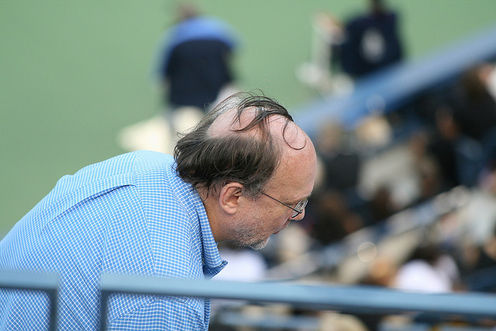
Hair loss is no longer an inevitable march to baldness. Medical advances over recent decades mean male hair loss can be treated. And it need not break the bank.
The cause of male pattern baldness is well established as an act of nature not nurture. Identical twins go bald at the same age, rate and pattern irrespective of diet, lifestyle or stress levels.
Baldness is a complex polygenic trait: up to five genes are involved, and it is the interplay between these genes, not unlike the interaction between the cards in a poker hand, that determine the specifics of male pattern hair loss.
So, what are the treatment options?
Finasteride
Finasteride is a Therapeutic Goods Administration-approved drug that dermatologists and general practitioners have been prescribing to treat hair loss for around 15 years.
It works by stopping the conversion of testosterone to dihydrotestosterone in the prostate, by blocking an enzyme called 5-alpha reductase.
You’ll need a prescription for finasteride and your doctor will explain the benefits and risks of the drug before you decide to proceed.
The benefits are clear: men who start taking daily finasteride at the first signs of hair loss will not go bald. Plus there are no interactions with other drugs.
But there is a small risk of sexual side effects such as such as erectile dysfunction, ejaculatory problems and reduced libido, which require careful management by an experienced doctor.
An added bonus is that finasteride reduces a man’s future chance of developing of prostate cancer. Though it does not increase longevity, as the reduction in risk is exclusively for low-risk prostate cancer which are not the type men generally die from.
The cost for a year’s supply of tablets starts at around as low as A$200 (plus the extra you will need to put aside for haircuts!).
Minoxidil
Developed in the 1950s as a tablet to treat high blood pressure, minoxidil was an abject failure due to unwanted hair growth. Re-invented as a lotion applied directly to the scalp, it was launched in the United States in 1988 and soon became popular around the world.
Minoxidil is also TGA-approved and available over the counter in pharmacies for between A$15 and A$60 per month, depending on the brand.
No prescription or trip to the doctor is required, but talk to your pharmacist if you are taking any other medicines, especially high-blood-pressure medication.

Hair removal laser has led to a renaissance in the use of minoxidil tablets, as doctors can now effectively manage the unwanted hair that was previously a deal breaker. Low doses of minoxidil, as low as one-fortieth of a tablet, can still grow hair with minimal effect on blood pressure and no need to put anything in your hair.
How they compare
While finasteride works best at arresting progression of genetically programmed hair loss, some men will achieve partial regrowth. The sooner you begin treatment, the more hair there is to protect.
Minoxidil is better at stimulating new growth rather than preventing progression. A bit like the bank manager who lends an umbrella when the sun is shining, and wants it back when it starts to rain, minoxidil works better before you go bald. Men who still have hair regrow more hair than men who have lost it all.
When used together, the combination of minoxidil and finasteride is a man’s best chance to both arrest hair loss progression and maximise hair regrowth.
Hair transplant surgery
Men whose hair is too far gone to be saved by tablets and lotions might consider hair transplantation surgery, a cosmetic surgical procedure that has improved dramatically in recent years.
Various techniques are available, but all involve taking hair-bearing skin from one part of the scalp and grafting these pieces of skin onto bald or thinning areas of the scalp.
The main down side, apart from the cost (A$5,000 to A$10,000, depending on the number of grafts required) is the linear scar left behind on the back of the head locking men into long hair styles.
Another option is follicular unit extraction. Rather than a strip of skin and a scar, donor tissue comprises multiple tiny punch grafts that heal invisibly by wound contraction. Further dissection of these grafts releases single hair follicle units that can be implanted one by one into the bald scalp to recreate a natural hair line.
The only limiting factor for follicular unit extraction is whether there is enough remaining donor hair to transplant. While chest and body hair have been used when donor hair is poor, artificial hair implants, also TGA-approved, remain the last resort. Artificial hairs cover the scalp, but do not grow and grey and regenerate like hair transplants.
Alternative therapies
What about other suggested treatments such as vitamins, dietary supplements, lasers, stem-cell therapy and platelet rich plasma? At this stage the most generous interpretation of the available data is that they are unproven, expensive and poor value compared with the TGA-approved treatments.
The take home message for boys staring at their bald fathers’ scalp and wondering what their genes have in store for them is, don’t panic, but don’t leave it too late.
Rodney Sinclair is principal investigator in a pharmaceutical company sponsored clinical trial investigating new treatments for male pattern baldness
